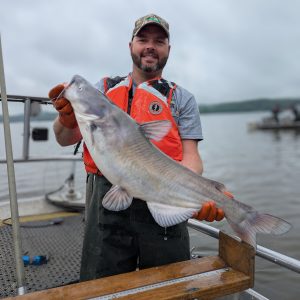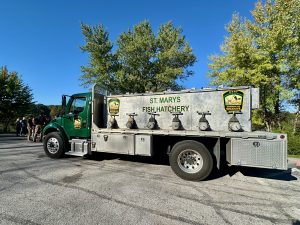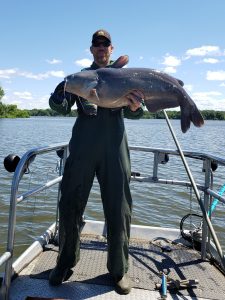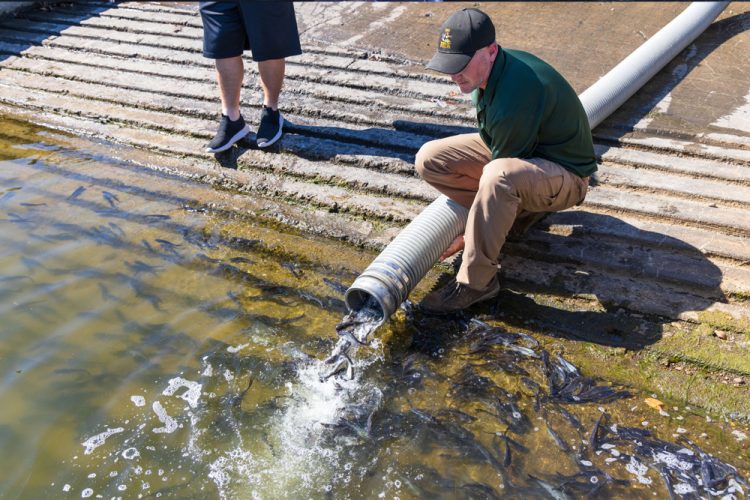An Ohio DNR employee stocks blue catfish at Seneca Lake. Photo by Josh Zielinski
The Science Behind Trophy Catfish Fisheries
By Anietra Hamper
Ohio is leveraging science and strategy to develop trophy catfish fisheries.
On an early October morning, the Ohio Department of Natural Resources Division of Wildlife fish-stocking trucks roll up to the launch ramp at Alum Creek Lake to release more than 33,000 blue catfish. Anglers and the public gather around to watch as the six-inch advanced fingerlings launch from tubes into the healthy waters of Alum Creek, one of nine reservoirs in Ohio being developed into trophy waters for blue catfish.

There’s a lot of pressure on these four-month-old fish to not only survive but to grow into the expectations of the fisheries biologists rearing them. The effort is a long game but one that is expected pay off for the state and anglers who are willing to seek new water to fish for a personal best catch.
“It takes time (maybe five to10 years) for the first-stocked blue catfish to grow to trophy sizes,” said Joseph Conroy, Fisheries Biology Supervisor, Inland Fisheries Research Unit, Division of Wildlife, Ohio Department of Natural Resources.
While some fisheries already have prime habitat to support long-living catfish with healthy trophy populations, you might not realize that others, like these targeted lakes in Ohio, are by design. The focus is on blue catfish because of their growth potential, but developing a trophy fishery also requires science and research to ensure an environmental and food web balance.
Trophy Growth Potential & Attracting Anglers
It’s no secret that big fish are big business. As blue catfish have the growth potential to tip the scales over 100 pounds, the interest in developing trophy fisheries with this species is motivated by attracting anglers who are eager to catch them.
“We know that inland anglers pursue many different sport fish in these waterbodies. Recognizing that providing trophy opportunities is an important aspect of providing diverse opportunities, we sought to expand inland trophy-fishing opportunities, and blue catfish provided an opportunity to do so,” said Conroy.
Ohio developed a 10-year tactical plan driven by a business model that relies on a feedback loop to determine each next step from year to year. This includes evaluating the status, developing both long-term and moderate-term plans, creating annual work goals, then evaluating outcomes. It also means considering whether Ohio’s inland lakes can sustain trophy fisheries, so regularly evaluating factors including potential threats to success and prey sources to support fish growth are necessary.
With evaluations and a plan in place, Ohio is in the big-fish game.
“Trophy fisheries are ‘Field of Dreams’ opportunities: If you build them (= trophy fish populations), they (= anglers) will come,” said Conroy.
The Long Game & Learning Curve

Fishery development, especially the trophy kind, does not have a quick return and requires a steep learning curve along the way.
“We expected that developing a trophy blue catfish fishery would require years; we did not know if it would take 5, 10 or 15 years,” said Conroy. “We knew that we needed to be patient and that we would need to rely on standardized surveys to provide information on abundance (how many blue catfish are in the population) and growth (how fast do blue catfish grow and does the number of blue catfish in the population affect growth).”
ODNR uses 35 inches as a standard target for determining a trophy-size blue catfish and relies on stocking, regulations and standardized data collection to know if it is hitting the benchmarks. At the time of the first blue catfish stocking in 2010, Ohio did not have established survey methods for those populations, so developing one was an important consideration for evaluating progress.
Ohio looked to other states like Kansas for guidance.
“Kansas stocked 15 or so reservoirs and successfully created fishable populations, some with very good growth. This demonstrated that it was possible and provided a road map. We weren’t starting from scratch,” said Conroy.
The Science of a Trophy Catfish Fishery
Developing a trophy catfish fishery requires more than just stocking fish. It must be supported with a vision of sustainability and a balance of the food web.
“Ultimately, we felt that understanding blue catfish growth—that relationship between the number of fish in the population and the food available—would be essential for developing trophy fisheries,” said Conroy. “We expected their diets and growth to be similar at small sizes but for growth rates and diets to differ as these species got larger. We wanted to test this expectation.”

The Ohio Division of Wildlife worked with professors, graduate students and technicians at Ohio State University’s Aquatic Ecology Laboratory to create a food-web diagram of the Alum Creek Lake and Hoover Reservoir sport fish communities. The research looked at how how blue and channel catfish fit into a reservoir food web and understand how to avoid diet overlaps.
“Food-web research broadly investigates ‘who eats who’ and energy flow between different species in the food web,” said Conroy.
The food web research tests expectations that blue catfish and channel catfish have similar diets at small sizes but that those diets change for fish at larger sizes. The goal is to identify if food competition exists between blue and channel catfish and understand how the feeding habits of blue catfish impact growth.
The preliminary research shows blue catfish diets rely primarily on forage fish like gizzard shad and bluegills, and that channel catfish have a more diverse diet that includes aquatic insect larvae and crayfish in addition to forage fish. Understanding that food consumption patterns differ among sport fish species was a breakthrough discovery.
“We always thought that catfish, bass and saugeye differed in food consumption; now we know. This is powerful,” said Conroy.
The research also supported the expectations about catfish growth. Populations with good channel catfish growth could be expected to have populations with good blue catfish growth and vice versa.
Trophy Fishery Outlook
Refining the management of trophy blue catfish fisheries is ongoing and evolving as Ohio becomes an example for other states looking to replicate the process with a solid science-based understanding of what it takes to do it.
(Anietra Hamper is a career television news anchor and investigative journalist turned award-winning outdoor writer specializing in fishing and outdoor adventure. Anietra travels the world fishing for catfish and other unique species in new destinations.)



